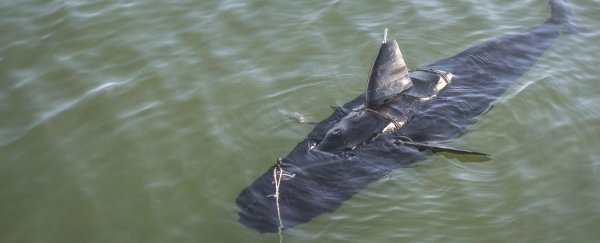
It may not be kitted out with a laser beam attached to its head (just yet) but the US Navy's new robot shark is still pretty awesome – so long as you don't accidentally encounter it at the beach.
Unveiled during a testing exercise at Virginia Beach in mid-December, the "GhostSwimmer" is an unmanned underwater vehicle designed to resemble the shape of a large fish. It's approximately 1.5-metres-long (five feet) and weighs nearly 45 kg (100 lbs). What's even cooler than its shark-shaped body – complete with the fear-inducing dorsal fin, and pectoral fins – is how the GhostSwimmer moves!
"It swims just like a fish does by oscillating its tail fin back and forth," said Michael Rufo, director of Boston Engineering's Advanced Systems Group (which developed the robot for the US Navy) on the project page. "The unit is a combination of unmanned systems engineering and unique propulsion and control capabilities," he says.
According to the project page the robot can operate from 25 centimetres (10 inches) to a maximum depth of 90 metres (or 300 feet). Thanks to a long-lasting battery, it is capable of operating autonomously for long stretches – though it must return to the surface to communicate information to technicians aboard the deploying ship. Alternatively, it can be connected to a 150-metre-long tether and operated via laptop.
Developers say its fish-like propulsion, manoeuvrability and appearance will enable more rapid movement and access into tougher environments, and could provide "additional security" on covert reconnaissance, surveillance and information-gathering missions. The robot can be used to inspect signs of damage on the hulls of friendly ships, to assist in port security, and in future, could play a larger role in replacing the dolphins and sea lions currently used by the US Navy to echo-locate underwater mines and missing equipment.
The robot was developed as part of a US Navy project called Silent NEMO, which is exploring "the possible uses for biomimetic, unmanned underwater vehicles in the fleet". Rufo says, in the Boston Engineering press release, that the robot "will allow the Navy to have success during more types of missions while keeping divers and sailors safe." It may be the largest fish-like robot (that we're aware of) but it's not the first.
The US Department of Homeland Security has also contracted the Boston Engineering firm to help develop its BIOSwimmer robot, which is modelled after the tuna.
Sources: The US Navy, Boston Engineering
